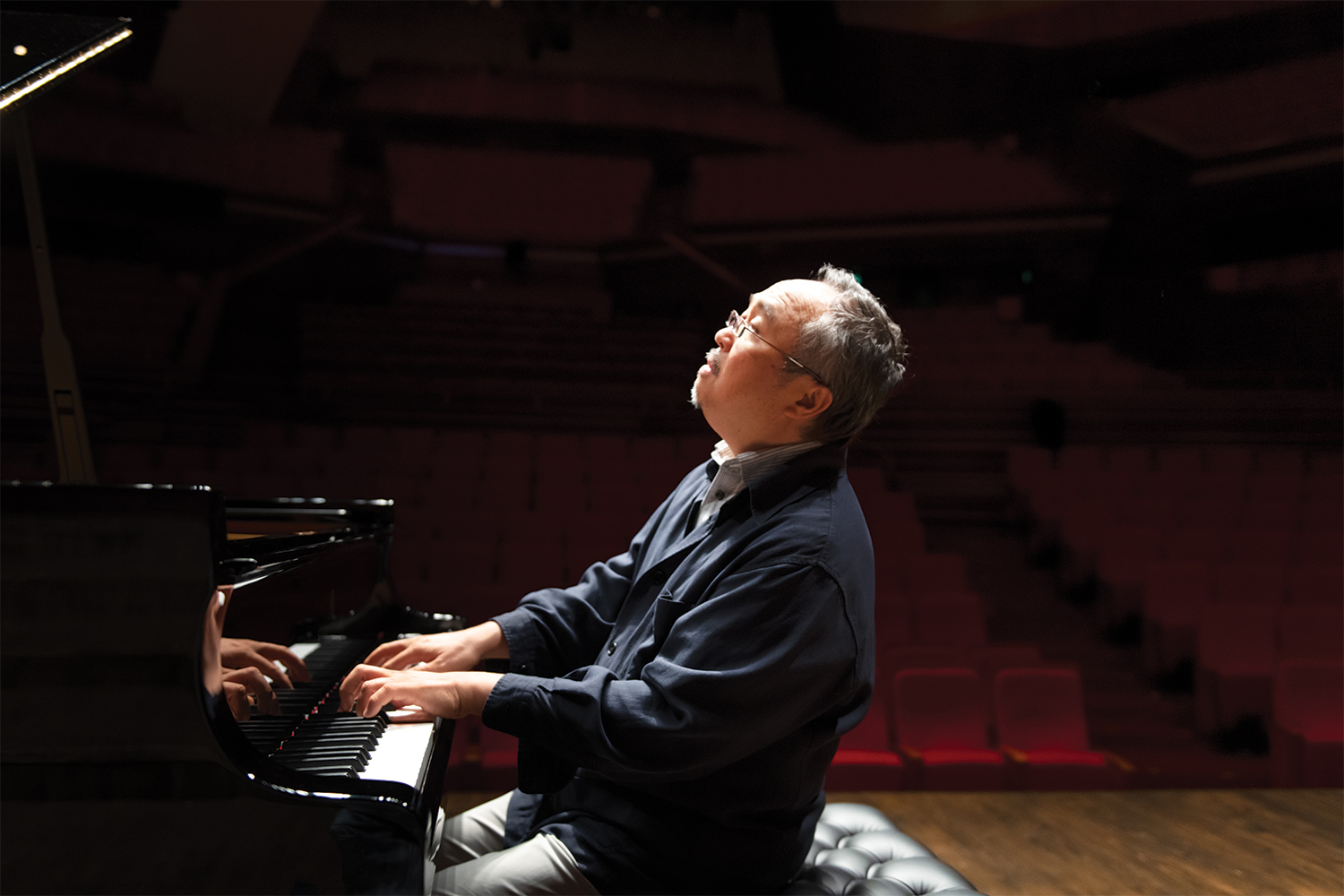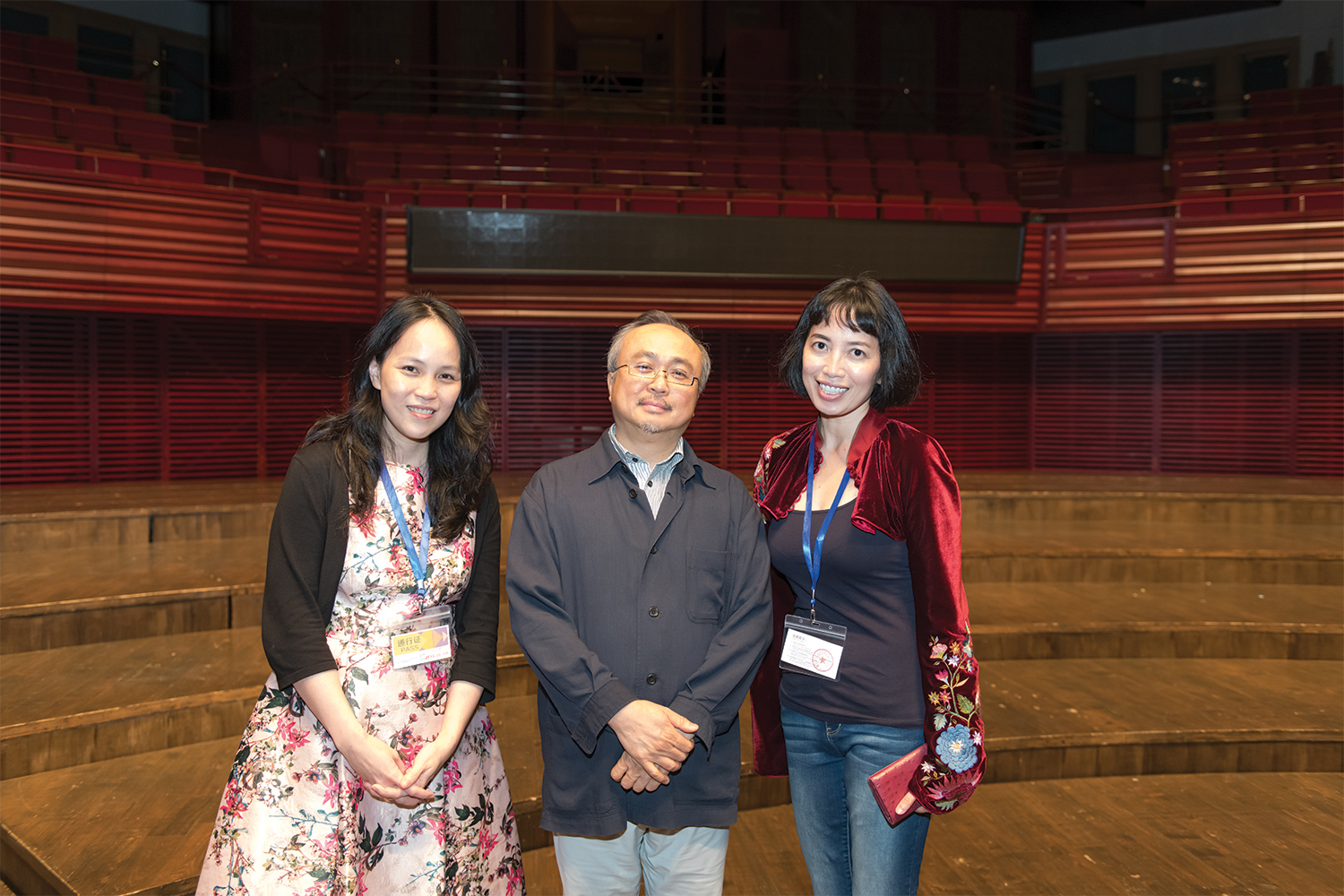Vantage Music & Tra Nguyen | June 2019 | Shenzhen
It was a bright Sunday morning in June. As an unprecedented mass of people flocked to Hong Kong Island, we crossed the border gingerly and took a short ride to Shenzhen Concert Hall, where Maestro Đặng Thái Sơn agreed to a short interview before his concert that night.

Family of Professional Musicians
The First Prize winner of the 1980 International Chopin Piano Competition, Đặng Thái Sơn is regarded as the first Vietnamese pianist to rise to international fame, but Sơn (in Vietnamese practice, it is customary to use the given name) was quick to dismiss the claim, “My mother and my aunt are actually the first concert pianists!”
Music runs deep in the family. “I was born into a very musical home,” Sơn recounted. “My grandfather, Thái Văn Lân, was one of the first Vietnamese to study Electrical Engineering at the University of Grenoble in France.” Lân returned to Saigon and became a prestigious intellectual, authoring textbooks on Practical Electricity. In his spare time, however, he would often pick up the violin and enjoy the company of music.
Vietnam was a French colony back then, and many Vietnamese viewed the piano, an invention of the West, as a symbol of status. “It was fashionable for kids to play music. For boys, it is the violin; For girls, it is the piano.” Most of them, like Lân, were only amateurs at best.
This was not the case with Lân’s daughters, Thái Thị Lang and Thái Thị Liên. In 1933, the 18-year-old Lang became the first Vietnamese to be accepted into the Conservatoire de Paris when she boldly went to France alone, studying with various masters such as George DeLausnay and Yves Nat. She eventually settled in Paris and developed a respectable career as a composer and concert pianist.
An Extraordinary Figure
The story of Liên is equally, if not more, eventful. “My mother, Liên, got a lucky break when she started learning the piano with Armande Caron, who has just moved into Saigon,” Sơn told us. By chance, Armande Caron was a student of Isidor Philipp, and learnt from the French teacher all the nuances of piano playing, especially that of Frédéric Chopin. In fact, Isidor Philipp studied piano under Georges Mathias, who was, in turn, a pupil of Chopin, allowing Liên to trace her music heritage directly back to the famous composer.
Liên’s life took a fateful turn in 1946 when she went to Paris as part of Ho Chi Minh’s delegation in a diplomatic visit to France. “It was after the end of the Second World War, and Ho was trying to garner support for the independence of Vietnam,” Sơn explained. “The delegates were there to contact the Communist Party in France and were hoping to sway the intellectuals in France to their cause.”
Whilst Ho’s negotiation for peace did not have much success, Liên fell in love with her fellow delegation member Trần Ngọc Danh, and they married shortly afterwards.
In 1948, Liên’s husband was appointed as the first Vietnamese ambassador in the Czech Republic, and Liên followed him to Prague, eventually entering the Conservatory of Prague and obtaining a diploma in the early 50s. It was a remarkable feat for a Vietnamese woman of her time.
Music was not Liên’s only preoccupation: “My mother was very patriotic and outspoken. Even in Prague, she would often be involved in many nationalist and feminist movements. She even participated at the Algeria and Hungary congresses of the Women’s International Democratic Federation, condemning the horrific French atrocities against women resisters.”
Back to the Jungles
In 1951, at the height of the First Indochina War (known in Vietnam as the Anti-French Resistance War), Liên brought her first daughter, at that time 22 months old, back to Vietnam via a secret resistance route in southern China. Hanoi was occupied by French forces, so Liên had no choice but to go inside the jungles of north Vietnam where the Viet Minh resistance lived.
“It was a very difficult time for my mother,” Sơn said. “She was like a princess during her times in Saigon and Prague, never knowing how miserable life can be. The change in environment was a severe shock to her. She even had to sleep in the animal barn once during the New Year!” Unfortunately, the jungles proved to be fatal for Liên’s husband, who died from tuberculosis shortly after arriving. However, Liên, with her strong personality, weathered through the hardships of the war, even putting her musical knowledge to good use by joining the Central People’s Dance Group, translating propaganda resistance songs into French, teaching and singing in performance groups, and leading the choir in patriotic performances to bolster the resistance’s morale.
The Vietnam School of Music
After the decisive Battle of Điện Biên Phủ in 1954, France withdrew from Vietnam, and Ho Chi Minh’s group moved back to Hanoi. Two years later, in 1956, Liên became one of the founders of the Vietnam School of Music (now known as the Vietnam National Academy of Music) and was placed in charge of the piano department. Initially, the conservatory did not offer university-level courses, aiming to provide higher qualifications for teachers instead, who were mostly amateurs at that time.
It was during this time that Sơn was born, after Liên, widowed, remarried the poet Đặng Đình Hưng, whom she met in her return to Vietnam during the War.

The American War
War invaded Hanoi again in 1965. “When I was seven, the war escalated from the south of Vietnam to the north, with America bombing North Vietnam with its air force.” The advent of the American War shattered the world as Sơn knew it. Fearing for their safety, everyone in Hanoi evacuated to a neighboring village in the mountain areas.
For the conservatory, relocation presented an additional challenge in terms of transporting instruments. “One can carry the violin on foot, and even the cello with some difficulty. But how about the piano?” Sơn remarked. There were four rivers separating Hanoi from the village 30 miles away, and no trains or cars could traverse the difficult terrain safely. “In the end, we tied all 60 upright and grand pianos to the back of buffalo carts and carried them all the way to the mountains.” They trudged along with the pianos under the violent beatings of sun and rain, jingling and tinkling with every bump on the road.
As expected, everything was in pieces when the crowd arrived at the destination – the pianos were breaking apart, and the strings were unstrung and broken. “Half of the pianos had no sound. Not only had the strings snapped, but the mechanisms of the piano were also destroyed by rain.” To complicate matters, living space was limited in the village, so the pianos were left in the open and were often subject to the forces of nature. “There was no electricity in the mountains, so when the piano got wet, we had to wait till the sun shines to dry it out.” To make use of the infrequent spells of sunlight, they would take apart the insides of the piano and leave them out to dry, and assemble the parts afterward. “That’s how I come to know so much about the mechanisms of the piano now!”
Practicing in the Mountains
Life in the mountains was not easy. “There was no food, no basic sanitization. My whole family was given a corner in one local villager’s straw hut, with no windows and only one bed for all of us. The bed became the single place where I sleep, where I eat, where I play with my friend, and where I do my homework.” Despite the harsh conditions, Sơn continued to learn music. “Out of the 60 pianos, only a few were playable, so we took turns practicing. In the first year, I was allotted a meagre twenty minutes every day.”
The constant threat of bombing loomed over them. “The Vietnamese in the village were unfamiliar with the piano, and always worried that the racket would attract the attention of the Americans, so we had to stop and hide whenever a plane flew across the sky.” Gradually, however, the students of the conservatory learnt to distinguish the planes by the sound of the engines. “When the Americans came, they moved very fast and sounded very aggressive. Vroom!” Sơn gestured as he imitated the engines of an American bomber. “We had to take refuge underground.”
It was an altogether different story for Soviet planes. “They were guarding the village, so their speed was more stable. It almost sounded like a Chopin nocturne, and we continued to practise, not wanting to waste our allotted time.”
Moonlight Mazurka
Humanity shone through even in the direst of situations. “We lived like a big family, sharing food, joy, pain, and also connecting with nature.” The mountains provided Sơn with an unforgettable experience: “It was a quiet night, and the full moon was gently illuminating the village. Suddenly, an ethereal melody arose from the blanket of silence. There, was my mother, sitting at the piano under the moonlight, playing Chopin’s Mazurkas.” It was the first time that Sơn heard the composer, and it left a lasting impression on him. “From then on, in my Vietnamese studies, I had in my mind only Chopin and nothing by any other composers: no Mozart, no Bach.”
In 1970, Liên was invited to the International Chopin Piano Competition, not as a performer but as a guest. “The competition was held in Warsaw, Poland, which was a communist state at the time. My mother was invited to observe the event as the head of Vietnam’s piano school.” When Liên returned to Vietnam, she brought with her complete recordings of Chopin’s works, along with a full set of scores. They were a godsend to Sơn.
“During the war, there were no music stores or photocopy shops, and every score was hand-copied. For seven years, everybody had to make copies by hand if they wanted to play a piece.” It was like a game of Telephone gone wrong. “After several iterations, we couldn’t even recognize what kind of music it was!” To Sơn, the scores were a trove of treasure. “Whenever my mother left home for the conservatory, I would take out the scores and explore every note and marking on it, comparing them with my hand-copied sheets. It was really interesting to find out the differences and to correct my playing.”
From Zero to Number One
In 1974, Sơn went to the Moscow Conservatory after a glowing recommendation from a visiting Russian pianist, Isaac Katz. He barely made it through the entrance examination.
“In Vietnam, I had some training in finger techniques, but it was far from professional. They let me in only because they heard a certain sense of musicality in me, but everyone agreed that my technique is virtually non-existent.” Unfortunately, as an institution for higher education, the Conservatory was a place for training in interpretation, “for moons, dreams, and imaginations, and no one had time for a jungle boy like me.”
No one, that is, except Professor Vladimir Natanson. “He was a low-profile professor, the oldest one at my time, and he spent a lot of time coaching me.” Unlike his fellow teachers who were mostly concert pianists, Natanson was more of a musicologist, renowned for his pedagogic expertise. “Natanson met with me two to three times a week, spending up to three hours each time.” Natanson gave Sơn a diverse selection of repertoires, addressing Sơn’s various technical deficiencies. “I played a lot of Prokofiev to develop strong fingers, which is a key aspect of the Russian school of playing. I also played some Haydn and Scarlatti in between.”
Sơn is extremely grateful to Professor Natanson. “A teacher is good only if he is a suitable teacher for my current level. Had I jumped right to the top of the ladder and found a professor who only talked about imagination, it would have been disastrous for me, because I was not ready for that.” Driven by a strong sense of motivation, Sơn developed an intensive regime to rapidly build up his proficiency under Natanson’s guidance. “I only ate and practiced throughout the whole day in my first year, leaving no single free minute.” At the end of the year, Sơn was already playing Brahm’s Paganini Variations. “The professors from my entrance examination couldn’t recognize me!”
Sơn’s performance was awarded a first in class, and his astonishing transformation attracted the attention of Tatyana Nikolayeva, one of the most distinguished professors in the conservatory, who mentioned his case in the school’s newspaper.
The Chopin Competition
Sơn became the centre of attention again in his third year when he came first in the Soviet-only audition for the 1980 International Chopin Competition. “I learnt all the notes of Chopin in Vietnam, but I never studied Chopin’s works in earnest until the third year.” Sơn had expressed his desire to play Chopin in the first year, but Natanson felt he was not ready. “You must be joking,” the teacher commented. Sơn made no mention of it until the third year, when he played to Natanson again, this time well-trained and well-prepared. To Sơn‘s delight, Natanson begrudgingly approved. “Maybe let’s work together,” he said.
For their third year, notwithstanding the strict requirements of the conservatory’s syllabus, Sơn and Natanson concentrated on Chopin. After a full year of studying, Sơn was still not too sure of himself, so he volunteered to audition for the competition, to see how well he can play. “If I had a chance, then I can go to Warsaw,” Sơn reasoned, “but if not, forget that.”
Sơn created a sensation in school when he passed the audition as number one. “It was seven months before the competition in Warsaw, and all the Soviet students couldn’t believe it.” Russians in the conservatory are very proud of their heritage, and they could not believe that anybody can play better than them. “If I were a Chinese or a Japanese, they would understand. But Vietnamese? Nobody understood that.”
Naturally, the whole school was curious. “Even Mikhail Pletnev, the biggest star in Moscow that time, was intrigued: ‘What is this about the Vietnamese boy?’” So Pletnev, who has never been to a concert or listened to any performances, sat down in Sơn’s class concert and heard his Chopin. “He still remembered it forty years later, reminding me about the concert when we met at the Chopin Festival last year.”
International Career
Sơn returned to Moscow after the competition, after a touching reunion with his mother and his aunt, whom he hadn’t seen since their separation in Paris forty years ago. “Even though I came first, I felt I’m still not ready, so I continued to study in Moscow.”
The decision was influenced in part by external factors. “I had some options at the time. One was in France, where I found a professor in the Paris Conservatory who was willing to take me in.” Unfortunately, the practicalities of the Cold War prevented that from happening. “The Vietnamese government rejected my application, telling me I had to either stay in Moscow, or go back to Hanoi.”
By the time Sơn obtained a postgraduate degree in Moscow in 1987, the political climate had considerably changed. “I decided to move to Japan, where I was offered the position of a visiting professor at the Kunitachi Music College in Tokyo.” For Sơn, this was a logical choice. “Japan supported my career greatly from the beginning. After the Chopin competition, I received a special prize from NHK TV, who was amazingly proud of my status as the first Asian to win the Chopin Competition.” The Japanese’s involvement was instrumental to Sơn’s career. “They wrote a letter to the Vietnam government, persuading them to allow me to perform and stay in Japan.”
Four years later, however, Sơn felt the need to move on. “I had a lot of concerts and a lot of money in Japan, but I began to feel stale and spoilt.” Sơn felt that his playing started to regress artistically, and decided to change environments again, emigrating to Canada in 1991. “Canada is the first time I fully encountered capitalism. Japan at that time was also capitalist but in a very Asian way.” To date, Sơn is living in Montreal, Canada, where his mother Liên also resides.
What’s Next?
Sơn is frequently invited to give masterclasses around the world, and this led him to develop great expectations on Asian pianists. “I think that the 21st century will generally be the golden age of Asia. If we look at the competitions nowadays, the prizewinners and those who are the most successful are mainly Asians.” Sơn predicted the emergence of the next pianist powerhouse. “Japan developed its distinct school of playing after the Second World War, churning out waves and waves of professionals, but it was caught up by Korea, Hong Kong, Taiwan, and eventually by China. As a powerful country with a huge population, China is home to many amazing talents. Now that China is developing music education aggressively and dynamically, I think that we will begin to see more and more Chinese pianists in the spotlight. When China decides to do something, they usually succeed.”
For now, that is. “Ten years later, maybe it would be time for Southeast Asian countries to shine, who knows?” ′
Interviewed by Vantage Music & Tra Nguyen, written by Chester Leung.


